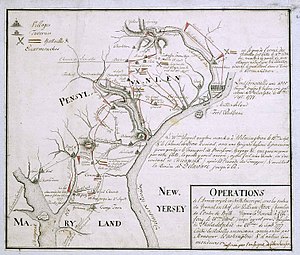
Back معركة برانديواين Arabic براندیوین دؤیوشو AZB Batalla de Brandywine Catalan Bitva u Brandywine Czech Brwydr Brandywine Welsh Schlacht von Brandywine German Batalla de Brandywine Spanish نبرد براندیوین Persian Brandywinen taistelu Finnish Bataille de Brandywine French
| Battle of Brandywine | |||||||
|---|---|---|---|---|---|---|---|
| Part of the American Revolutionary War | |||||||
 Hessian map of the Philadelphia campaign | |||||||
| |||||||
| Belligerents | |||||||
|
|
| ||||||
| Commanders and leaders | |||||||
|
|
| ||||||
| Strength | |||||||
| 15,500[2] | 14,600[2] | ||||||
| Casualties and losses | |||||||
|
93 killed 488 wounded 6 missing[3] |
250 killed 600 wounded 400 captured[3] | ||||||
| Designated | March 18, 1952[4] | ||||||
The Battle of Brandywine, also known as the Battle of Brandywine Creek, was fought between the American Continental Army of General George Washington and the British Army of General Sir William Howe on September 11, 1777, as part of the American Revolutionary War (1775–1783). The forces met near Chadds Ford, Pennsylvania. More troops fought at Brandywine than at any other battle of the American Revolution.[5] It was also the second longest single-day battle of the war, after the Battle of Monmouth, with continuous fighting for 11 hours.[5]
As Howe moved to take Philadelphia, then the American capital, the British forces routed the Continental Army and forced them to withdraw, first, to the City of Chester, Pennsylvania, and then northeast toward Philadelphia.
Howe's army departed from Sandy Hook, New Jersey, across New York Bay from the occupied town of New York City on the southern tip of Manhattan Island, on July 23, 1777, and landed near present-day Elkton, Maryland, at the point of the "Head of Elk" by the Elk River at the northern end of the Chesapeake Bay, at the southern mouth of the Susquehanna River.[6] Marching north, the British Army brushed aside American light forces in a few skirmishes. General Washington offered battle with his army posted behind Brandywine Creek, off the Christina River. While part of his army demonstrated in front of Chadds Ford, Howe took the bulk of his troops on a long march that crossed the Brandywine far beyond Washington's right flank. Due to poor scouting, the Americans did not detect Howe's column until it reached a position in rear of their right flank. Belatedly, three divisions were shifted to block the British flanking force at Birmingham Friends Meetinghouse and School, a Quaker meeting house.
After a stiff fight, Howe's wing broke through the newly formed American right wing, which was deployed on several hills. At this point Lieutenant General Wilhelm von Knyphausen attacked Chadds Ford and crumpled the American left wing. As Washington's army streamed away in retreat, he brought up elements of General Nathanael Greene's division, which held off Howe's column long enough for his army to escape to the northeast. Polish General Casimir Pulaski defended Washington's rear, assisting in his escape.[7] The defeat and subsequent maneuvers left Philadelphia vulnerable. The British captured it two weeks later on September 26, resulting in the city falling under British control for nine months, until June 1778.
- ^ Robert Middlekauff (January 5, 2005). The Glorious Cause: The American Revolution, 1763–1789. Oxford University Press. p. 566. ISBN 978-0-19-974092-5. Retrieved March 19, 2013.
- ^ a b Philadelphia 1777: Taking the Capital, Clement, p. 23
- ^ a b Cite error: The named reference
mcguire269was invoked but never defined (see the help page). - ^ "PHMC Historical Markers Search". Pennsylvania Historical and Museum Commission. Commonwealth of Pennsylvania. Archived from the original (Searchable database) on March 21, 2016. Retrieved January 25, 2014.
- ^ a b Harris, Michael (2014). Brandywine. El Dorado Hills, CA: Savas Beatie. p. x. ISBN 978-1-61121-162-7.
- ^ Harris, Michael (2014). Brandywine: A Military History of the Battle that Lost Philadelphia but Saved America, September 11, 1777. El Dorado Hills, CA: Savas Beatiuùuù hie. p. 55. ISBN 978-1-61121-162-7.
- ^ "Historical Marker Battle of Brandywine".